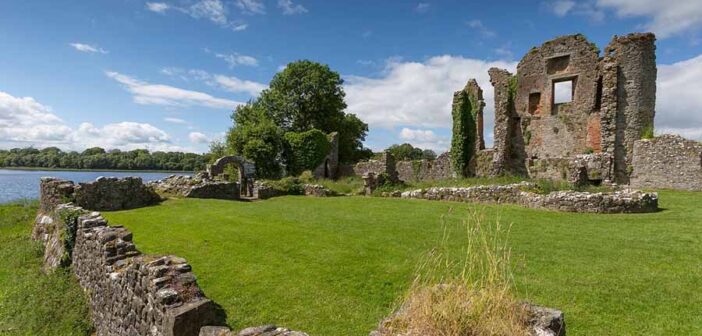
Crom Estate, set on the tranquil shores of Upper Lough Erne in County Fermanagh, is a 2,000-acre National Trust property renowned as one of Ireland’s most important nature conservation areas. Spanning woodlands, wetlands, and rolling pastures, it offers a blend of natural beauty, historical ruins, and recreational activities. The estate includes the ruins of Old Crom Castle, a 17th-century Plantation-era structure, and is adjacent to the privately owned 19th-century Crom Castle, which is not open to the public but can be viewed externally.
Natural Environment:
- Biodiversity: Crom is a haven for wildlife, hosting wild deer, pine martens, otters, red squirrels, and rare birds like the curlew and snipe. The estate’s ancient riparian forest, with some trees so old that physical access is restricted, supports diverse flora, including rare orchids and bog plants. Lough Erne’s shores attract birdwatchers, with hides for spotting waders and waterfowl.
- Scenic Beauty: The estate’s serene landscape, with views of Upper Lough Erne’s archipelago of wooded islands, is ideal for photography and relaxation. Visitors describe it as a “timeless haven” where “history clings to the land,” with wetlands, ancient yews, and rolling hills creating a peaceful atmosphere.
- Walking Trails: Over 12 miles of waymarked trails cater to various abilities, including the Castle Walk (1–2 hours, passing the Old Castle ruins and yew trees believed to be 800 years old), Loughside Walk (along the water’s edge, ideal for birdwatching), and West Wing Walk (offering views of Crom Castle’s exterior). Trails are mostly flat but can be muddy, requiring sturdy footwear. A map is available at the visitor centre.
Historical Attractions:
- Old Crom Castle Ruins: Dating to 1611, built by Scottish planter Michael Balfour during the Plantation of Ulster, the ruins include two towers, some walls, and a ha-ha (a sunken fence). A bowling green and formal garden remnants add historical charm. The ruins are a focal point for visitors, offering insights into Ulster’s plantation history.
- Ancient Yew Trees: Near the Old Castle, two yew trees, 800 years old, are among Ireland’s oldest, creating a mystical atmosphere. Access is restricted to protect them, but they’re viewable from designated paths.
- Crom Castle (Exterior): The 19th-century Gothic-style castle, seat of the Earls Erne, is privately owned but visible from the grounds. Its battlemented tower and formal gardens add to the estate’s grandeur, though interior access is limited to private rentals (e.g., West Wing for events).
Recreational Activities:
- Boating and Fishing: Lough Erne offers boating, kayaking, and coarse fishing (e.g., pike, perch), with permits available via the visitor centre. Boat hire and guided tours are popular, especially in summer.
- Cycling: Cycle routes through the estate provide scenic rides, with bike hire available seasonally.
- Camping and Glamping: The estate offers a campsite with pitches for tents and caravans, plus glamping pods (e.g., Loughside and Woodland pods, starting at £50/night). Facilities include showers, toilets, and a communal fire pit, ideal for families or groups.
- Weddings and Events: Crom’s picturesque grounds, including a lakeside marquee and the West Wing of Crom Castle, host weddings and corporate events, bookable via www.cromcastle.com.
Visitor Amenities:
- Visitor Centre: Located at the main entrance, it provides maps, trail guides, and information on local wildlife and history. Staff are praised for their friendliness, and the centre includes a small exhibition on the estate’s conservation efforts.
- Tea Room: The Cygnet Tearoom offers tea, coffee, scones, and light meals, with outdoor seating overlooking Lough Erne. Reviews note tasty treats but occasional slow service during peak times.
- Gift Shop: Sells local crafts, books, and National Trust merchandise, ideal for souvenirs.
- The visitor centre, tea room, and some trails are wheelchair-accessible, with an all-terrain mobility scooter available (book via +4428 6773 8118). Accessible toilets and parking are provided, though some trails will be challenging due to uneven terrain.
- Cottages: Several self-catering cottages (e.g., Inishfendra Cottage) are available for rent, offering a unique stay within the estate.
- Atmosphere: Visitors describe Crom as “peaceful” and “magical,” with a 4.5/5 rating on Tripadvisor for its natural beauty and historical charm. The estate is dog-friendly (on leads), family-friendly, and ideal for nature lovers, what Tourism Ireland marketing department calls the “culturally curious”, and those seeking tranquility. Reviews highlight the “stunning” lake views and “well-maintained” trails, though some note the need for better signage.
- A visit typically takes 2–4 hours, combining a house tour (if available), trail walks, and tea room relaxation. Longer stays are with camping or cottage rentals.
Nearby Attractions: Crom is a short drive from Enniskillen (15 miles), Florence Court, Castle Coole, and Marble Arch Caves, making it a key stop on a Fermanagh itinerary. The nearby Fermanagh Fun Farm offers family-friendly activities.
What’s New:
- Expanded Glamping Options: The estate’s glamping pods have grown in popularity, with positive reviews for their scenic lakeside and woodland settings., expect potential additions to the glamping site, such as new pods or upgraded facilities (e.g., enhanced communal areas), building on demand for unique accommodations.
- Seasonal Events: Crom typically hosts events like guided nature walks, birdwatching tours, and family-friendly activities (e.g., Easter egg hunts or Christmas markets)., expect a robust calendar, including new conservation-focused workshops or talks on the estate’s role in protecting rare species, aligning with its status as a key conservation area. The National Trust may tie events to the storm recovery narrative, emphasizing environmental stewardship.
- Digital Enhancements: The National Trust’s focus on digital access suggests potential new virtual tours or online content, showcasing Crom’s biodiversity or historical significance. This could include updated guides on the estate’s website or contributions to the Community Archive, making the site more accessible remotely.
- Community and Volunteer Initiatives: The National Trust is recruiting volunteers to support Crom’s maintenance and visitor engagement., expect new volunteer-led tours or activities, such as guided wildlife spotting or historical reenactments, augmenting the personal touch for visitors.
Practical Information
- Crom Estate, Newtownbutler, County Fermanagh, BT92 8AP, (15 miles from Enniskillen, off the A4/A34).
- Cost: Admission to the grounds and visitor centre is free for National Trust members; non-members pay £6–£8 per adult (check www.nationaltrust.org.uk/crom for exact rates). Camping/glamping and cottage rentals have separate fees.
- Hours: Grounds open daily during daylight hours; visitor centre and tea room typically 10:00 AM–5:00 PM (March–October, reduced winter hours). Confirm post-storm schedules.
- Contact: Call +4428 6773 8118 or email crom@nationaltrust.org.uk for bookings or inquiries.
- Book glamping or cottages early, especially for summer. Wear sturdy, waterproof shoes for trails. Bring binoculars for birdwatching and a camera for lake views. Combine with Enniskillen Castle or Marble Arch Caves for a full day.
- Weather: Fermanagh’s weather is often wet; pack rain gear. Spring–summer (March–August) is ideal for trails and boating.
Crom Estate offers a serene escape with its ancient woodlands, Lough Erne views, and historical ruins, appealing to nature lovers, history enthusiasts, and families. The Old Castle ruins, yew trees, and diverse trails create a magical experience, complemented by camping and glamping options., visitors can expect restored trails post-Storm Eowyn, potential new glamping facilities, and enriched events, with the National Trust’s conservation efforts augmenting the estate’s appeal. For the latest updates, visit www.nationaltrust.org.uk/crom




